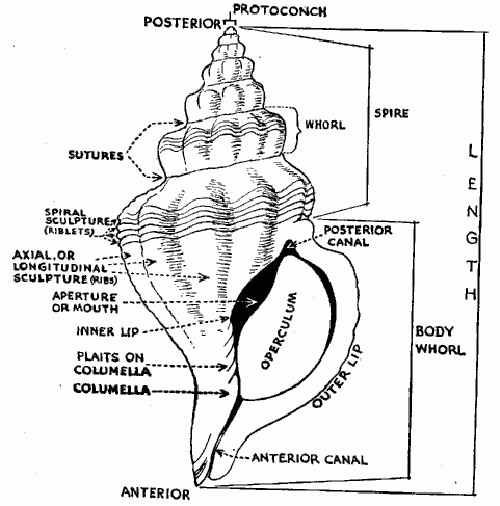Gastropods (Class Gasteropoda) (Cambrian – Present)
They are molluscs which live in water or on the land with asymmetrical and twisted body. Shell consists on only one conical element with helical involvement. They have a foot and they breath trough gills or lungs.Morphology
Gastropods have simple morphology, but some elements are very important to define them.External shell (Fig.1) may be divided in two parts:
• Spire: the pointed end of the shell. From the apex of the spire, one can count the number of complete whorls and each of them is joined to the next along a suture. The angle formed by the point of the spire, or the spiral angle, is important in identification. The first whorl is known as protoconch, which is the young stage of organism.
• Last whorl: it’s the bigger one and it actually housed most of the snail. In this last part of the shell there is the aperture, which has some characteristics. The outer edge of the aperture is known as the peristome, while the inner lip has smooth callus called inductura. Internally, it’s possible to observe the junction of the inner whorls of adjoining which produces a fused structure along the axis of the shell known as the columella. About the ornamentations, it’s possible to observe costae, spinae, varices and growth lines.

Fig.1: External morphology of the shell
Gastropods in thin section
Gastropod shells are primarily aragonitic but this internal microstructure is not usually preserved and is typically replaced with drusy calcite spar. Gastropods are recognized in thin section by shell morphology which consist of distinctly curved shapes spiraled around a central axis.Uses in Paleontology
Since they have wide stratigraphic range of distribution, they are used as tool for studies in paleoecology. page created by Dalila Grilli (Department of Earth Sciences, Milan, Italy)Bibliography
• D.R Prothero, Bringing Fossils to Life, 2004 – pp 290-291


.jpg)
.jpg)
.jpg)
.jpg)
.jpg)
.jpg)
.jpg)
.jpg)
.jpg)
.jpg)
.jpg)
.jpg)
.jpg)
.jpg)
.jpg)
.jpg)
.jpg)